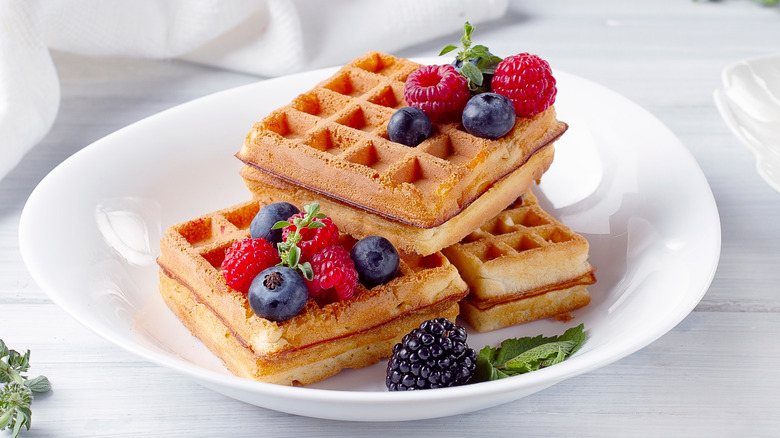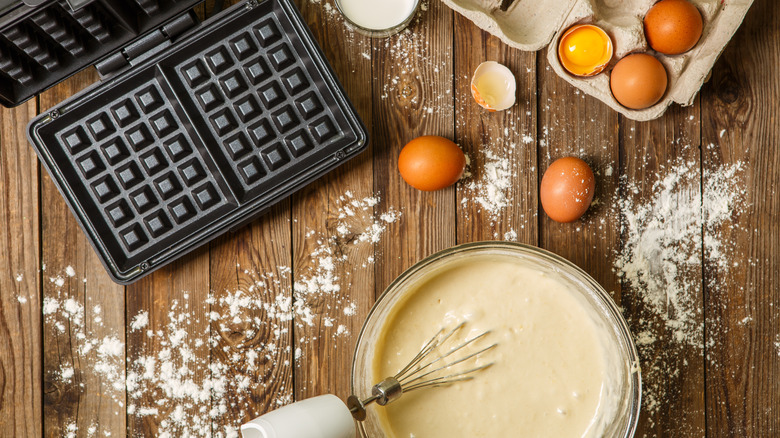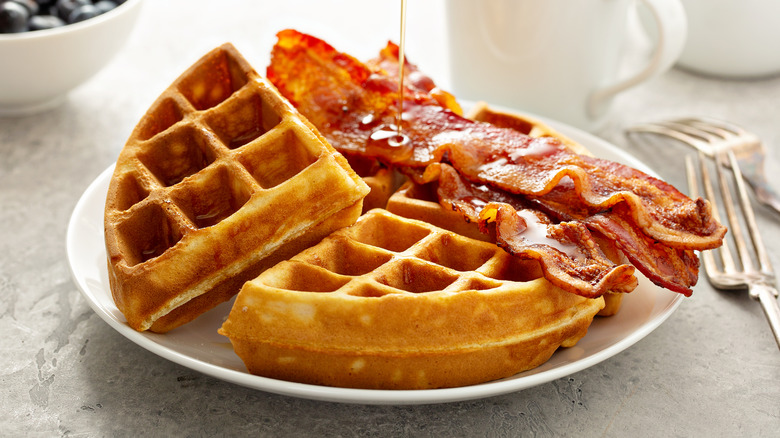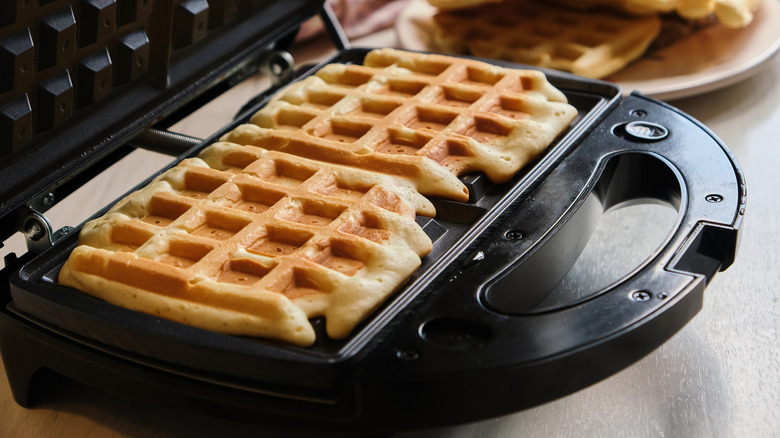What's The Difference Between Regular Waffles And Belgian Waffles?
Ahh, waffles. They've been around since medieval times (via Smithsonian Magazine) and are now enjoyed all over the world in different varieties, according to Insider. In the Netherlands, you can have a stroopwafel filled with caramel or syrup. In Japan, you can have fish-shaped Taiyaki waffles filled with red beans or custard.
In the United States, you can choose between varieties of frozen store-bought waffles or make your own homemade buttermilk waffles. The breakfast pastry can be jazzed up with tasty toppings like butter, syrup, powdered sugar, strawberries, whipped cream, Nutella, blueberries, and even fried chicken.
But the Belgian waffle is where things get really interesting. Belgian waffles are similar to regular waffles in a few ways. For example, they both have the same checkered impression pattern with pockets, but there are a few key differences between the two involving their ingredients, appearance and texture, and the type of waffle iron used to make them.
High quality ingredients make a difference
Thomas Degeest, the Belgian-born founder of New York waffle truck Wafels & Dinges, shared his thoughts with Daily Meal on the do's and don'ts of Belgian waffle-making. He said they should be made from scratch, not from a box, so save the Bisquick or Hungry Jack for another recipe.
Now for the ingredients. Most of the ingredients needed for Belgian waffles are the same as those needed for regular waffles, but Degeest adds that they should include high-quality flour, real vanilla extract, lots of butter, and high-quality sugar. Belgian Boys claims that crunchy pearl sugar is the type that should be used. Fun fact: You can make your own pearl sugar at home.
You'll also need a few other ingredients, including a leavening agent, but Belgian and regular waffles don't use the same leavening agent. For regular waffles, baking powder is typically used, but Belgian waffles use yeast, as The Cafe Sucre Farine explains. This inclusion of yeast is the primary ingredient difference between Belgian and regular waffles.
Belgian waffles are thicker and fluffier
The appearance is another key difference between Belgian and regular waffles. If you're looking at a thick, fluffy waffle, chances are good it's Belgian. That's because the yeasted batter used to make Belgian waffles produces thick, fluffy waffles with deep pockets for you to fill with the toppings of your choice, according to Belgian Boys. That is, if you're eating them in the United States.
In a HuffPost article about the history of the Belgian waffle, the writer explains how a Belgian waffle made in Belgium, doesn't typically have or need toppings. Waffles there are made as street food and intended as something you can grab and eat on the go with your hands. However, in the United States, Belgian waffles are typically eaten with toppings, since they're usually served as a plated meal.
The overall texture of Belgian waffles also differs from regular waffles. It's crispier, naturally, thanks to the pearl sugar that caramelizes when heated, according to the HuffPost. You can make regular waffles crispy, too, but you usually have to make adjustments to the recipe. And some say this is the only waffle recipe you'll ever need, calling for milk, egg yolk, and vanilla, with the option to add in whatever you like, such as chocolate chips, bananas, or blueberries.
Using a waffle maker can make a difference
The last difference between Belgian and regular waffles involves the type of waffle maker used to make them. Although every waffle maker includes two metal plates with a specific pattern on it, not all waffle makers are the same. Take those fish-shaped Japanese Taiyaki waffles as an example. To make fish-shaped waffles, you obviously need a waffle maker with fish patterns.
With Belgian waffles, if you want thick, fluffy waffles, the waffle maker needs to have deep grooves to give the yeast batter enough room to rise. On the other hand, a regular waffle maker's grooves are more shallow than a Belgian waffle maker (per Food Champs). However, many waffle makers sold in the United States are suitable for making Belgian waffles, even if they don't explicitly say "Belgian waffles" on the label.
So now you know the difference. Belgian waffles use yeast as the leavening agent while regular waffles use baking powder. Belgian waffles also use pearl sugar, which makes them crispier than regular waffles. And if you opt for Belgian waffles, you'll need a waffle maker with deep grooves to accommodate them.



